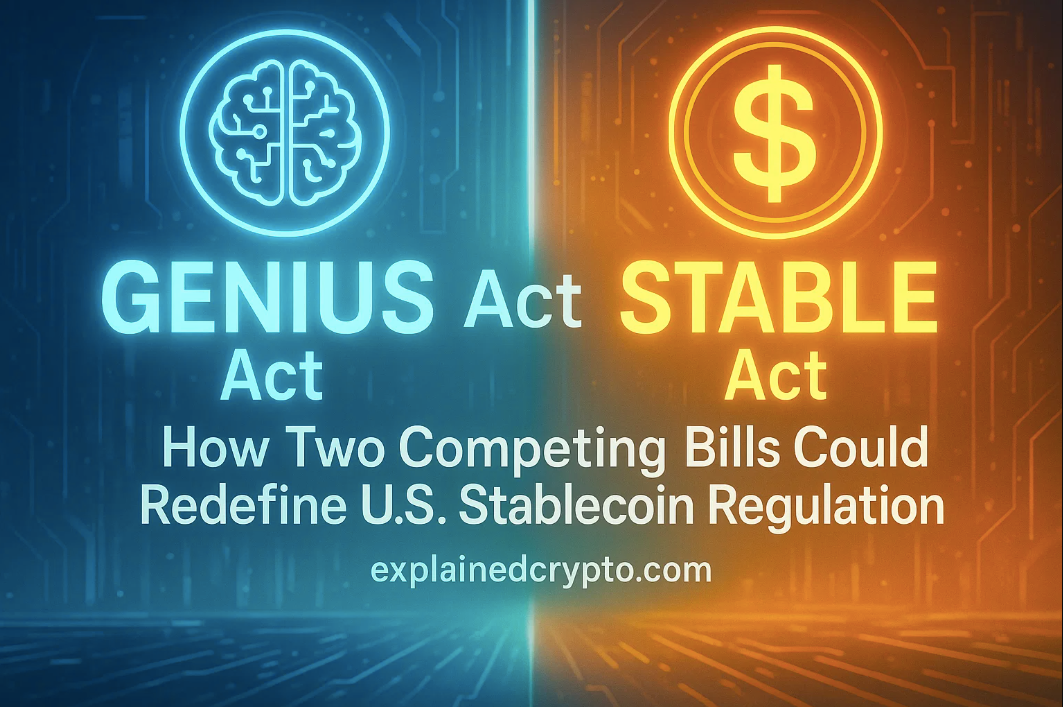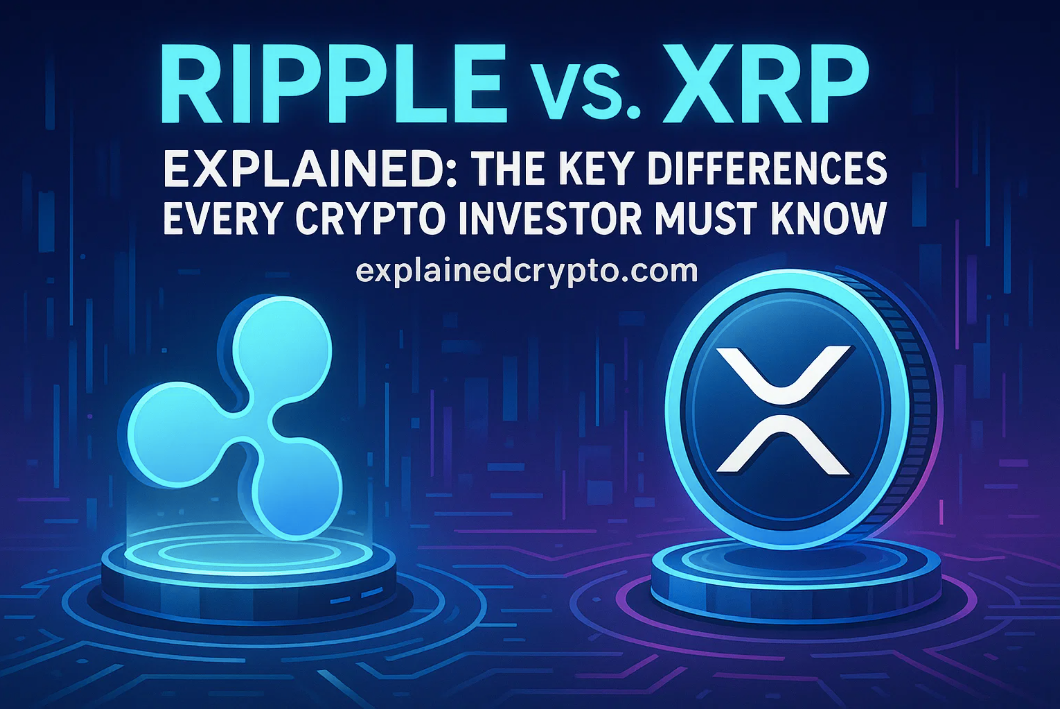- The GENIUS Act promotes a dual state-federal framework to encourage stablecoin innovation, while the STABLE Act enforces strict federal control.
- GENIUS could lower entry barriers and foster competition; STABLE may bolster trust but risks consolidating power among large incumbents.
- Striking a balance between innovation and oversight will shape the future of stablecoins and U.S. dollar dominance globally.
The U.S. stands at a pivotal juncture in digital asset regulation. With stablecoins becoming critical tools for payments and settlements, lawmakers are racing to design guardrails that balance innovation with systemic safety. Two major legislative proposals have emerged: the GENIUS Act and the STABLE Act.
While both aim to regulate payment stablecoins and protect consumers, they differ dramatically in scope, oversight, and philosophy. The GENIUS Act takes a dual state-federal licensing approach to encourage innovation, while the STABLE Act prioritizes strict federal control and banking-grade oversight. Understanding their distinctions is vital for anyone invested in the future of U.S. crypto policy.
What Is the GENIUS Act?
Introduced on February 4, 2025, by Senators Bill Hagerty, Tim Scott, Kirsten Gillibrand, and Cynthia Lummis, the Guiding and Establishing National Innovation for U.S. Stablecoins (GENIUS) Act seeks to establish a clear legal structure for stablecoin payments.
- March 17, 2025: The Senate Banking Committee passed a revised version by an 18–6 bipartisan vote.
- June 17, 2025: The full Senate passed it 68–30, signaling strong bipartisan support.
- The bill now awaits debate in the Republican-controlled House.
Key Features of the GENIUS Act
- Dual Licensing: Issuers can choose state or federal registration. Issuers with >$10B market cap must register federally.
- 1:1 Reserve Backing: Stablecoins must be fully backed by high-quality liquid assets like cash or U.S. Treasurys.
- Transparency & Audits: Monthly reserve disclosures audited by certified firms.
- AML Compliance: Issuers classified as financial institutions under the Bank Secrecy Act, subject to user verification and suspicious activity reporting.
- Consumer Protections: In bankruptcy, stablecoin holders are prioritized over other creditors.
- Regulatory Clarity: Payment stablecoins are not securities or commodities under federal law.
Supporters say this hybrid model could boost U.S. dollar dominance globally while fostering innovation at home.
What Is the STABLE Act?
The Stablecoin Transparency and Accountability for a Better Ledger Economy (STABLE) Act was introduced by Representatives French Hill and Bryan Steil. It aims to bring strict federal oversight to payment stablecoins, addressing systemic risk and consumer protection concerns.
- April 3, 2025: The House Financial Services Committee passed the STABLE Act, sending it to the House floor for a full vote.
- The bill builds on former President Donald Trump’s policy push to bring stablecoins onshore as tools to extend U.S. dollar influence.
Key Features of the STABLE Act
- Restricted Issuers: Only federally approved banks, nonbank subsidiaries, or state-qualified entities may issue stablecoins.
- 1:1 Reserve Backing: Backed by cash, short-term Treasurys, or FDIC-insured deposits.
- No Interest Payments: Issuers cannot pay interest on stablecoin holdings.
- Transparency & Reporting: Monthly reserve reports audited by public accounting firms; false claims face $5M fines or 20 years imprisonment under Sarbanes-Oxley.
- AML Compliance: Must follow the Bank Secrecy Act and related AML rules.
- Enforcement Power: Federal regulators can impose $100K/day fines, remove executives, or suspend operations.
- Consumer Protections: Strict asset segregation prioritizes users over creditors during insolvency.
Supporters argue the STABLE Act would legitimize stablecoins and protect users, while critics warn its banking-style burdens could stifle smaller innovators.
GENIUS vs STABLE: Key Differences at a Glance
| Feature | GENIUS Act | STABLE Act |
|---|---|---|
| Regulatory Approach | Dual: State or federal licensing | Strict federal oversight only |
| Eligible Issuers | State/federally licensed entities (flexible) | Only federally approved banks, nonbanks, state-qualified |
| Market Cap Threshold | >$10B must register federally | No threshold; all federal |
| Reserve Requirements | 1:1 high-quality liquid assets | 1:1 high-quality liquid assets |
| Transparency | Monthly audits, public reserve disclosure | Monthly audits, executive certifications |
| FDIC Insurance | Not required | Not required (but FDIC-insured deposits allowed) |
| Penalties | Civil enforcement | Civil fines ($100K/day) + criminal penalties |
| Algorithmic Stablecoins | Allowed with conditions | Two-year ban |
| Innovation Stance | Innovation-friendly, encourages new entrants | Risk-averse, favors large incumbents |
| Consumer Protections | Bankruptcy priority for users | Strict segregation, user priority in insolvency |
This table illustrates how the GENIUS Act emphasizes flexibility and market entry, while the STABLE Act emphasizes rigor and systemic safety.
Potential Impact on the U.S. Stablecoin Market
If passed, the GENIUS Act could catalyze growth by lowering entry barriers, especially for smaller fintechs and startups. Dual licensing could let state regulators experiment with innovative stablecoin models while maintaining federal guardrails for larger players.
In contrast, the STABLE Act’s centralized model could favor well-capitalized firms like Circle (USDC) and PayPal (PYUSD), which already operate under heavy compliance regimes. While this may increase trust and adoption among institutions, it could consolidate power and reduce competition.
“The GENIUS Act offers a sandbox; the STABLE Act builds a fortress,” said one Washington-based fintech lobbyist.
However, both bills impose strict reserve and disclosure standards, which may squeeze profit margins and discourage purely speculative projects, shifting the market toward payment-focused use cases.
How They Compare with the EU’s MiCA Framework
The EU’s Markets in Crypto-Assets (MiCA) regulation, in force across 27 member states, offers a unified framework for crypto-assets including stablecoins.
| Feature | GENIUS Act (US) | STABLE Act (US) | MiCA (EU) |
|---|---|---|---|
| Regulatory Scope | State & federal split | Federal-only | EU-wide, single regime |
| Licensing | Dual-path licensing | Limited to banks/nonbanks | EU registration for all issuers |
| Reserve Rules | 1:1 backed, monthly audits | 1:1 backed, monthly audits | Capital + liquidity reserves |
| Consumer Protections | Bankruptcy priority | Asset segregation | Redemption rights, capital buffers |
| Innovation Stance | Encourages competition | Favors incumbents | Balanced innovation approach |
MiCA strikes a middle path—allowing innovation but imposing clear EU-wide compliance standards. By comparison, the U.S. remains fragmented, with GENIUS and STABLE offering opposing regulatory visions.
Criticism of the GENIUS Act
While praised as innovation-friendly, the GENIUS Act faces several criticisms:
- Licensing Burdens: Smaller issuers worry dual licensing could be costly and complex.
- Financial Stability Concerns: Critics warn looser rules may increase systemic risk if stablecoins scale rapidly.
- Domestic Focus: The Act overlooks cross-border payment opportunities, especially in fast-growing fintech hubs like Brazil and India.
- Big Tech Entry Risks: Community banks fear tech giants like Apple or Meta could dominate stablecoins under a light-touch regime.
Some analysts argue the Act could concentrate power among large financial institutions while stifling smaller innovators—the very opposite of its stated goal.
Criticism of the STABLE Act
The STABLE Act has also drawn heavy criticism from regulators, industry leaders, and consumer advocates:
- Consumer Safeguards: Critics argue the Act lacks mandatory FDIC insurance or guaranteed redemption mechanisms, leaving users exposed during depegging events or fraud.
- Federal Overreach: State regulators warn federal preemption could undermine state innovation roles.
- Innovation Risk: Crypto developers caution that heavy compliance could stifle technological experimentation and delay adoption.
- Global Ripple Effects: International observers fear U.S.-centric rules could disrupt global stablecoin markets or drive activity offshore.
Even subtle price dips in USDC and USDT after the bill’s draft release hinted at investor unease.
What Happens Next?
The GENIUS Act now heads to the Republican-controlled House, where it faces debate, possible amendments, and a full vote. The STABLE Act awaits a House vote after passing the Financial Services Committee.
If both advance, lawmakers may attempt to merge provisions into a single compromise bill—potentially combining the GENIUS Act’s flexibility with the STABLE Act’s rigor.
Whatever the outcome, these bills will shape how the U.S. integrates stablecoins into its financial system—and by extension, how the U.S. dollar competes as a digital currency worldwide.
Also Read: Proof of Work vs Proof of Stake: The Ultimate Beginner’s Guide (2025 Update)
Balancing Innovation and Safety
The GENIUS and STABLE Acts present two divergent paths for U.S. stablecoin regulation. GENIUS prioritizes innovation and state-federal collaboration, while STABLE demands strict federal control to minimize systemic risk.
Finding a middle ground will be essential. Overregulation could stifle U.S. competitiveness, while lax oversight could jeopardize consumer safety and financial stability. As the debate intensifies, the outcome will profoundly impact crypto markets, fintech innovation, and the future of digital money in the U.S. and beyond.
Disclaimer: The information in this article is for general purposes only and does not constitute financial advice. The author’s views are personal and may not reflect the views of explainedcrypto.com. Before making any investment decisions, you should always conduct your own research. explainedcrypto.com is not responsible for any financial losses.





